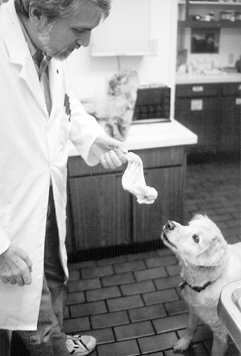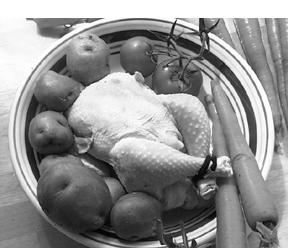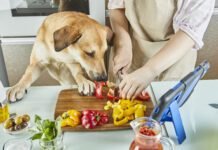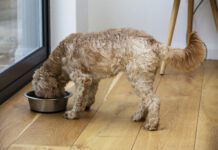When dog lovers switch their pets from commercial food to a well-balanced, raw diet, they typically report improved health, brighter eyes, a shinier coat, calmer behavior, and easier yard cleanup chores. A puppy’s first eight weeks set the stage for a lifetime of health or illness, so it isn’t surprising that puppies weaned on raw food grow up to out-perform dogs weaned on kibble or canned food, even if both are fed raw food as adults. Raw-weaned puppies nearly exhaust their breeders’ vocabularies, for these are the healthiest / strongest / liveliest / calmest / smartest / most wonderful pups that ever lived.
What is the best way to introduce raw food to infant puppies? And what is the best age for starting the weaning process? A survey of raw-food breeders shows that there are no hard and fast rules. Raw-food puppies seem to thrive on all kinds of “first foods” and weaning schedules.
Following the leader

Many breeders follow the guidelines Juliette de Bairacli Levy has published for half a century in her books on natural rearing. “A properly weaned puppy is a joy to see and possess,” she wrote in The Complete Herbal Handbook for the Dog and Cat. “It is each puppy’s right that it be fed foods which will not damage or degenerate its new body, but improve and safeguard its health.”
De Bairacli Levy believes that slow rather than rapid weaning is necessary, because the intestines and stomachs of infant carnivores cannot deal with solid food until after four weeks. She warns that grain-based “weaning foods,” such as commercial kibble, are especially likely to distend the stomach and create an ideal environment for worms and infectious bacteria.
De Bairacli Levy’s preferred weaning food is raw, unpasteurized goat’s or cow’s milk. To one quart of raw milk, she adds one tablespoon raw honey. Each four-week-old puppy receives a serving of honey-laced milk plus one teaspoon “Natural Rearing Tree Bark Gruel,” a blend of slippery elm tree bark, barley flour, dill, marshmallow, and other herbs that provide nourishment while soothing the digestive tract. This gruel is served lukewarm, at body temperature. Gradually, small amounts of shredded poultry or meat, pureed or finely minced vegetables, and other ingredients are added, and portions increase in size as the puppies grow.
Marina Zacharias, of Jacksonville, Oregon, distributes Natural Rearing products, raises Basset Hounds and is an honorary godmother to countless litters from other breeds. Following de Bairacli Levy’s guidelines, she introduces raw meat toward the end of the puppies’ fifth week, feeding early morning and noon meals of milk and gruel, then afternoon and evening meals of meat, green vegetables, and whole-food nutritional supplements.
“As the pups get a little older,” she says, “they receive fundamentally the same components I feed to my adults. The milk/gruel meals become the basis for the grain meal (I gradually reduce its milk content and thicken the gravy component), and the meat meal is changed as they grow and adapt from a ‘mushy’ meat to small chunks to normal adult-sized chunks.
“Then, at approximately eight weeks, raw bones can be introduced after the meat meals as a treat, not as a replacement for the meat. Chicken wings or necks work well for this purpose. Please remember, these bones are soft when raw. Never feed cooked bones.”
New leaders
Wendy Volhard developed her Natural Diet in 1973, based largely on Juliette de Bairacli Levy’s recommendations. Volhard says she tested the results on dogs at all stages of life for more than 12 years. “The testing consisted of complete blood work using serum chemistry profiles as well as feces and urine analysis,” wrote Volhard. “We are now on the fifth generation of dogs raised this way, and some breeders are on their seventh generation of Natural Diet dogs. From time to time we have tried other natural diets or combinations of commercial foods and natural feeding, plus one experiment where all the dogs were put on commercial food. Nothing comes close to producing the health, vitality, and longevity of the Natural Diet.”
Together with veterinarian Kerry Brown, Volhard wrote a book, Holistic Guide for a Healthy Dog, which was first published in 1995 and recently released in its second edition in softcover. The book offers detailed instructions for introducing raw food to four-week-old puppies, starting with four feedings per day of raw milk, honey, slippery elm powder, baby cereal, vitamin C, and, with the evening meal, cod liver oil. Volhard recommends separating the mother dog from the litter during meals, feeding each puppy from an individual bowl, making fresh water available, and letting the pups play in fresh air and sunshine after feeding. The puppies continue to nurse after meals until they are fully weaned.
At 36 days, the puppies eat morning and noon meals of raw milk, honey, slippery elm powder, baby cereal, and small amounts of vitamin/mineral and homeopathic supplements. In the afternoon and evening, they eat small amounts of fresh, raw meat, brewer’s yeast, bone meal, herbs or greens, kelp, wheat bran, wheat germ, cod liver oil, and nutritional supplements. The puppies continue on this diet until they are seven months old.
Experiment and adapt
Christine Swingle, who raises West Highland White Terriers in Bristol, Connecticut, followed the Natural Rearing method for several litters with good results. “Then I read various books about wolves,” she says, “and I thought about how the wolf mom and even some domesticated dogs regurgitate food to start the weaning process. Baby wolves don’t get goat’s milk and powdered barley flakes; they eat a partly digested serving of whatever their mothers had for dinner. Domestication, starting the weaning process too early, and other factors have silenced some of our dogs’ natural instincts, so the modern brood bitch doesn’t regurgitate to feed her pups. But why couldn’t I mimic the process? After doing more research, I began to look at weaning differently.”
Last June, Swingle let three-week-old puppies play with chicken necks after cutting them with scissors between the vertebrae to loosen the meat. “It was a good first exposure to raw food,” she says. “The pups didn’t have any teeth, so they weren’t really eating anything, but it was fun watching them gum the necks. Their mom assumed the necks were for her, and when the pups were finished, she got their leftovers.”
Swingle continued to give each pup a raw chicken neck every day, and just before they turned five weeks old, she introduced what she calls “mama BARF.” (The acronym BARF was coined by Australian veterinarian and raw foods advocate Ian Billinghurst, and stands for either Bones And Raw Food or Biologically Appropriate Raw Food.) To guide her puppy food preparation, Swingle says she tries to “keep in mind what might be in the stomach of a lactating wolf.”
Using her Vita Mix blender, Swingle combines ¼ cup lean, organic, free-range turkey or chicken, a few drops of Willard Water extract, a drop or two of flaxseed oil, one teaspoon alternating organ meats (chicken gizzard, chicken or beef liver or heart), and one teaspoon NR Treebark Gruel. After pureeing these ingredients, Swingle adds a sprinkle of Prozyme digestive enzyme powder and enough water to turn the sticky paste into a liquid soup, then lets it stand at room temperature for 15 minutes. Swingle started her four-week-old Westies on a teaspoon of the mixture three times a day, gradually increasing to six daily feedings of two or more teaspoons each by the end of the week.
“The pups dove right in,” she says. “At first I made the mistake of making the mixture too thick, and it stuck like peanut butter in their mouths. Once I diluted it with a little more water, all was fine. I allowed them to nurse as long as Hannah (their mother) wanted them to. I wasn’t concerned about the calcium content of their first solid food because they were getting the best possible calcium from Hannah’s milk.
“I kept this up, using lean chicken or turkey as the muscle meats and adding a variety of organ meats. The pups continued to nurse and, once a day, gum their chicken necks. By the time they were almost six weeks old, their teeth were beginning to bud through, and they were able to pull some of the meat from the necks.”

When the puppies were six weeks old, Swingle began adding ground chicken necks to their diet. “I bought an electric meat grinder,” she says, “which made my life much easier. I also began adding a different pureed vegetable every day, starting with ¼ teaspoon and increasing daily, and I added a small a amount of vitamin C.”
Soon the puppies were alternating between raw beef and poultry. Once they had teeth, they were given recreational bones to work on, such as lamb shank, beef rib, and veal neck. “These they relished with all the vigor of wolf pups,” says Swingle.
During the eighth week, the mother put an end to nursing, and the puppies were fully weaned. They ate the same variety of muscle meats, organ meats, raw meaty bones (small chicken necks work best for this breed), pureed vegetables, and supplements that Swingle feeds her adult Westies, only in smaller proportions. The supplements include natural vitamin E, vitamin C, Natural Rearing Seaweed Mineral Food, and a variety of oils.
“Hannah’s babies thrived and never had loose stools. They are solid, well-muscled, alert, intelligent, well-socialized, and never missed a beat. I think I’m onto something. Every day that goes by, I’m in awe of the condition and overall vitality of these Westies, all thanks to their natural diet.”
Works for big dogs, too
Janet Klapac, who raises Bernese Mountain dogs in North Lima, Ohio, researched researched diets before she raw-fed her dogs. “I planned to breed my female when she was two,” she says, “but I just wasn’t sure about feeding during pregnancy or introducing food to weaning pups. None of the diets I studied seemed quite right. I had real misgivings about the bone meal and grains that they called for.
“Then I read Give Your Dog a Bone by Ian Billinghurst, and everything fell into place. I put both of my dogs on the Billinghurst diet, and they thrived.” When they were four weeks old, Klapac quartered chicken backs and gave each puppy a piece. “They were just amazing!” she says. “They dug right in, grabbing and chewing. It was great to see them take to raw bones so easily and happily. Each day they ate more and more of the bones, not just the meat. A bit later, I introduced ground chicken and veggies. I make a frozen convenience food (Three Cheers Raw! Raw! Raw!), so this became the puppies’ lunch. At bedtime we called them into their big cage to gnaw on pork or beef bones. These pups were beautiful. They had gorgeous coats and solid muscle. Their stools tested clean, so we never even wormed them.”
Klapac also gives raw chicken necks to her puppies when they are about six weeks old. The enthusiastic pups sometimes swallow the necks whole, but have no problem digesting them. “Every now and then a pup would eat too much too fast or swallow a piece that was too large, but every single time, the piece came right back up and the pup would chew it again,” she says.
To help keep the puppies healthy, Klapac educated their buyers to the advantages of feeding raw. “I would not sell a pup to someone who was not open to trying raw food,” she says. “I gave them Billinghurst’s book and many reference lists as well as food to get them started. Young animals need the strongest immune systems possible. They are going through tremendous stresses – rapid growth, both mental and physical, weaning from mom, new sights and sounds, in some cases vaccinations, and the serious distractions of moving to a new home. They need the support of a natural, species-appropriate diet. And the best part is that natural rearing is the easiest way to go.”
Comparing raw-fed and traditionally fed siblings
Shelley Fritzke, who raises German Shepherd Dogs in British Columbia, has raised two litters on a raw, natural diet. One of them gave her a dramatic opportunity to compare puppies on home-prepared raw food with kibble-fed pups. “There were 10 puppies,” she says, “all of which were uniform in size and weighed the normal amount for this breed. For the most part, the delivery was very easy, but the mother began panting very hard the following day, and we took her to the vet. As a result of her medical treatment, she stopped nursing. The puppies did not belong to us because we had leased the bitch to a breeder who had asked us to whelp the litter. When we started bottle-feeding the four-day-old puppies, their owner decided to help out. She took six of the pups, and we kept four, including three of the smallest.
“Both of us bottle-fed the pups with a homemade formula. I decided to wean my four pups at 3½ weeks. Had the pups been on their mother, I would not have weaned them so early, but under the circumstances, it seemed like the right thing to do. I started them with pabulum and goat’s milk, just to ease into the raw, natural diet. I also fed their mom at the same time. She stayed close to the pups even though her milk had dried up.
“By the second day of weaning, the pups ignored their pabulum and ran straight to Mom’s bowl. They dove into it and she let them. I took her food and watered it with a bit of goat’s milk and fed them that. The pups loved it, and that is what they ate for the next two weeks, with less and less goat’s milk added to it.
“These pups had shiny coats, were very active, were very content, and their stools were perfect. At 10½ weeks, we brought all 10 pups back together so they could spend the next two weeks with Mom. I believe it is important for puppies to be with their mother during this time as she teaches them a lot of important things.

“When the owner arrived with her six pups, I was shocked. These puppies were half the size of mine, their coats were dull, they had little pot bellies, their eyes were runny, and they all had the runs.
“She had weaned them at four weeks onto puppy kibble soaked in water. They were still getting the puppy formula in a saucer. She said they would not drink plain water, while mine had been drinking water since three weeks of age. All the pups were checked for worms, coxidiosis, and giardia, and the results were negative.
“Before she saw my four pups, the owner said that hers were doing well and that they looked normal, like her eight previous litters. She had told me that 3½ weeks was way too early to wean the puppies and she did not approve of the way I was feeding them, but even she was surprised at the difference between the two sets of pups. I was so shocked that I had another breeder come to look at them. She has since switched her dogs to a raw, natural diet. I also videotaped the pups.
“Meanwhile, the puppies’ owner decided that the difference was due to the mom dog feeding the puppies that stayed with her. This was not the case, which my vet can verify, for she saw the pups and their mother every two days for the first three weeks of their lives. The owners’ pups had an extremely hard time digesting any kind of food. Her vet says that is because they were not on their mother, who would have given the pups digestive enzymes and other nutrients through her milk. I do not doubt that this is true, but my pups did not receive her milk, either, and they thrived on their raw food.”
While the two groups of puppies lived together, Fritzke tried to feed them separately, because the owner wanted her kibble-fed pups to continue eating kibble. “It was nearly impossible to keep them in their separate bowls,” she says, “so I gave up. For the next two weeks, all the pups received some raw food and some kibble. By the end, they were all eating mostly kibble, and the six smaller pups were looking much better and catching up in size. Unfortunately, I could not get their stools stabilized before they left again. They had some good days, but then their diarrhea would return.
“To keep a long story short, by the time the pups were five months old, all six of the kibble-weaned puppies had cataracts, including some in both eyes, while the four I weaned on raw food are fine and healthy. I asked to take back the pups with cataracts because I believe that this condition can be cured 100 percent with the right nutrition and supplements, but the owner refused. When I looked into juvenile cataracts, I found that the main cause in puppies is malnutrition and a lack of B vitamins. My four pups got an abundance of these vitamins in their raw meat, and earlier, when they were being bottle-fed, I gave them a liquid vitamin called Vitamino. The owner had refused to give this to her pups.”
Recently, Fritzke has been working closely with a friend’s six puppies. “They are bigger than kibble-fed pups and, like my raw-weaned puppies, they’re very content and alert,” she reports. “Pictures of them at two weeks show them looking like four-week-old puppies. At three weeks of age, they go right away to Mom’s dish of food to join in. They are allowed to have a bit of her food along with their nursing. My friend has decided to use a commercially prepared raw diet as the concept of natural feeding is new to her and she does not feel comfortable making it up for the puppies herself.”
Fritzke follows Ian Billinghurst’s diet and the suggestions in his book Raise Your Pups with Bones. “I usually start the weaning process with raw, green tripe (cow’s stomach) as the protein source,” she says. “It is full of digestive enzymes and many other good things, and I feel it gives the pups a boost as their bodies learn to digest solid food. From there I move to beef, then to chicken. I also feed the pups ground chicken necks and backs.”
No health problems
In Dacoma, Oklahoma, Asian Shepherd breeder Pril Zahorsky follows the Billinghurst diet fairly closely. “I do not breed very often,” she says, “so I have weaned only one litter of this giant-sized farm dog on raw food. After that litter, which was about two years ago, I will never use commercial food again.”
These puppies did not have to be “introduced” to raw food, says Zahorsky. “They already know raw food and bones. When they got their first taste of raw, meaty bones, they began a series of almost wolf-like, satisfied vocalizations. It was like sitting in the forest and hearing a wild, natural litter.”
Zahorsky started her pups on raw food at about 2½ weeks. “I buy chicken necks, which I beat with a hammer a la Billinghurst, so they are mushy,” she says. “Then I stand guard to watch as they attempt their first meals. Sometimes I have to pull a chunk out of one of their mouths, for they don’t have enough teeth as yet. They literally chew off more than they can bite. My tiny puppies growl when others get too close, and some of them roll and tumble to a secluded corner, where they can gnaw on their chicken necks in peace.”
The raw-weaned Asian Shepherds controlled their bowels and kidneys sooner and better than other litters, says Zahorsky. “Cleaning up after them was sooo much easier. To protect their joint health, we do not put our puppies on any slick surfaces and use only old, soft blankets in the whelping box so their little feet do not touch hard or slippery surfaces. I have to do a mountain of laundry to keep those old blankets clean, but it is much easier dealing with BARF feces. This was a charming, easy litter, full of fun and really easy to care for. The puppies are almost two years old now, and we have had no reports of any health problems at all. Their dispositions are partially the result of good parents, and partially, I suspect, a result of their raw food. All of the puppies’ owners are feeding the BARF diet.”
Improving the wild diet
In the wild, infant wolves, coyotes, foxes, and other canines are weaned on whatever food their mothers regurgitate and whatever game they have access to after the rest of the pack has eaten. There are no hard and fast rules about the puppies’ age, serving portions, or the contents of their first meals.
This flexibility enables generation after generation to survive in times of scarcity and abundance. Although different experts propose different schedules and formulas for the weaning of domesticated dogs, raw-fed American puppies, like their cousins in the wild, seem to thrive no matter when and how they are introduced to the food they will eat as adults.
-By CJ Puotinen






How much Vitamin O is safe to give my bottle baby (puppy)?
If a raw bone has been left in very cold refrigerator for over a month how do I k ow if bone is bad to give to my 1 year puppy?